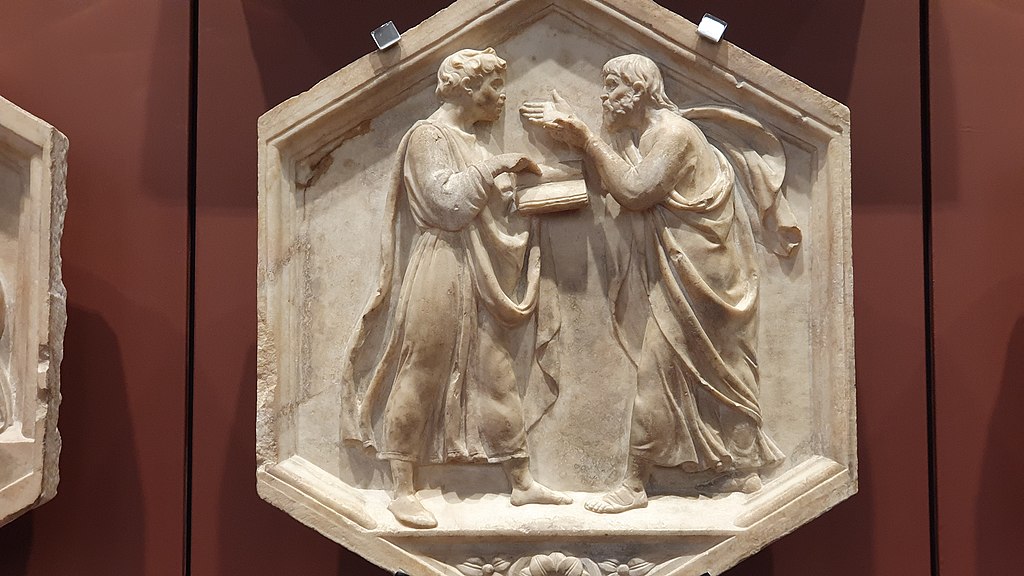
The night sky has always been a source of wonder not only for the ancient Greeks but for everyone on this planet.
Particularly, however, to the ancient Greeks, it was a vast canvas of endless possibilities—a frame dotted with hidden planets and shiny stars upon which they painted their myths and stories.
The story of Greek astronomy reveals a world in which mythological interpretations and sophisticated mathematical models merge together, showcasing the profound impact of the Greeks on our understanding of the cosmos to this day.
The dawn of Greek astronomy: Myths and early observations
As usual, our story with the Greeks begins with myths.
Hesiod and Homer were the two main characters of this story. They were the men who laid the foundations with their epic tales of how the world began. These stories weren’t just entertainment, however. They were early attempts of the Greeks to actually understand the heavens above their curious heads.
Stars and planets were gradually given names, their movements were meticulously observed, and the curiosity of those who wanted to find answers was being stretched beyond the Earth day after day—or should we say, night after night.
This was a time when Greek observations began to merge with the astronomical knowledge of other peoples, such as the Babylonians and Egyptians, who had already wondered about the hidden truths of our universe.

From Thales to Plato: A cosmos of philosophy
Enter the philosophers. Thales of Miletus sparked a groundbreaking revolution, proposing the unthinkable. Water was the essence of all matter, and when we say all matter, we mean even of the stars. Thales was a pre-Socratic Greek philosopher, mathematician, and astronomer who is credited as one of the first to propose naturalistic explanations for the world. One of them was this theory he came up with.
It was a fundamentally bold step away from myth and towards a more structured search for rational explanations.
On his behalf, Anaximander, his famous pupil, envisioned the Earth floating in space and surrounded by rings of fire. This was another bold statement for his era.
Pythagoras, on the other hand, suggested that the Earth was actually a sphere, contradicting what the human senses could grasp as real.
Finally, Plato managed to build on these revolutionary ideas, claiming that the cosmos around us was a universe of perfect geometric shapes. This set the stage for a mathematical understanding of the stars, that would, later on in human history, change the way we understand the world we live in.
These parallel narratives of some of the most iconic Greek thinkers reveal how ancient Greek astronomy evolved. Step by step, it went from the mythological to the mathematical, influencing centuries of celestial observation and theory.
The mathematicians’ sky: From Eudoxus to Ptolemy
Around 350 BC, Eudoxus of Cnidus introduced the concept of concentric spheres. This was yet again another groundbreaking idea that allowed the Greeks to conceptualize a more structured view of the heavens. His model, though it was clearly imperfect, was a bold attempt to map the heavens mathematically. Following Eudoxus, Callippus and Aristotle refined this model, making it much more complex and closer to the observed celestial phenomena with which we are familiar today.
This model of Eudoxus was a stepping stone, inspiring others like Callippus and Aristotle to refine and expand our understanding of the world around and above us. Aristotle, in particular, championed the idea of a geocentric universe, a belief that stood unchallenged for thousands of years.
Then came the mathematicians.
Apollonius and Hipparchus pushed the boundaries further. They managed to devise models to predict the movements of the stars and planets with remarkable—to this day—precision. The star catalog of Hipparchus was a monumental achievement in this route, mapping the positions of numerous stars with unprecedented accuracy. He is also remembered for the discovery of the precession of the equinoxes. This was truly a testament to the growing sophistication with which the Greeks observed the sky.
However, it was Ptolemy who compiled the Almagest. This was a book of comprehensive theories that synthesized and expanded upon the astronomical knowledge of his time. The work of Ptolemy blended observation with mathematical theory and remained a cornerstone of astronomy through to the Middle Ages.
Legacy and influence: Beyond the Hellenistic world
The profound influence of Greek astronomy on our world didn’t end with the demise and fall of the Hellenistic world.
The texts of many Greek thinkers were translated into Arabic and became a vital link to the Renaissance. This sparked a new era of astronomical discovery in Europe, leading to today’s unimaginable achievements in the field of astronomy.
Indian astronomers, too, were influenced by Greek texts. The Greek thinkers and their world helped them integrate Hellenistic concepts into their celestial models, which were already advanced on their merit.
Evidence of the long-lasting legacy of Greek astronomers today is the fact that the names given to stars and constellations by the Greeks still adorn our night sky.
This combination of mythic and mathematical elements illustrates the crucial role of the ancient Greeks in the story of astronomy. Their quest to understand the cosmos laid the foundations for the scientific research that continues to this day.
See all the latest news from Greece and the world at Greekreporter.com. Contact our newsroom to report an update or send your story, photos and videos. Follow GR on Google News and subscribe here to our daily email!



